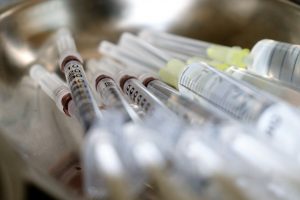Japan’s government is introducing a contentious new policy in which coronavirus patients with moderate symptoms will isolate at home instead of in hospitals, as new cases surge in Tokyo to record levels during the Olympic Games.
Prime Minister Suga Yoshihide’s plan, which aims to save hospital beds almost exclusively for those with serious symptoms or at risk of developing them, is a major policy shift as new cases in the capital have more than tripled since the Olympics began on July 23.
Tokyo reported 4,166 new cases on Wednesday, an all-time high since the pandemic began early last year. Nationwide, Japan registered 12,076 cases on Tuesday for a 956,407 total, including more than 15,000 deaths.
The new policy, introduced this week, was debated in parliament on Wednesday. Opposition as well as some governing party lawmakers and experts charged that the lives of people isolating at home without adequate care would be at risk.
Suga, who has been criticized for insisting on hosting the Olympics despite public virus fears, says there is no evidence linking the upsurge in cases to the Games.
He said the home isolation policy is meant to ensure that hospital care is available for seriously ill patients, and that the new plan is only for areas where hospitals are severely strained.
Infections, propelled by the more contagious Delta variant, could accelerate to 10,000 a day in Tokyo alone by mid-August, some experts say. They called for a current state of emergency in Tokyo and five other areas to be expanded nationwide. The emergency measures, which focus on alcohol bans and shorter hours for eateries, are increasingly ignored by the public, which has tired of restrictions.
NHK public television and other media reported that Suga is expected to expand a milder version of the emergency measures to 13 prefectures.
“The pandemic has now entered a new phase,” Health Minister Tamura Norihisa said in parliament. “Hospital capacity is limited.”
He defended the home isolation policy as necessary to prevent a medical collapse similar to what happened in April in Osaka, when thousands of people became sicker and some died at home while waiting for hospital beds.
Tamura, cautioning against a repeat of that situation, urged people to avoid all non-essential outings to slow infections.
In Tokyo, more than 14,000 patients with mild symptoms are currently isolating at home — more than a 10-fold increase from a month ago — and about 8,400 others are waiting for beds in hospitals or special hotels.
Opposition lawmakers criticized Suga for not increasing hospital capacity sufficiently despite warnings about the fast-spreading Delta variant. Coronavirus treatment in Japan is limited to public and university hospitals that have adequate facilities and expertise.
“Lives that can be saved will be lost,” said Yamanoi Kazunori, a lawmaker from the opposition Constitutional Democratic Party of Japan, calling isolation at home “abandonment.”
Dr. Omi Shigeru, the government’s top medical adviser, said patients at risk of developing serious symptoms while staying at home will need to be given proper support by community physicians who make household visits.
Japan has managed to keep its cases and deaths lower than much of the world, but testing is still insufficient and Tokyo’s positivity rate stands at 20 percent, indicating widespread infections. Its seven-day moving average is 8.3 cases per 100,000 people, compared to 2.9 in India, 6.5 in the Philippines, and 27.3 in the United States, according to Johns Hopkins University.
Suga said vaccinations of elderly people have significantly reduced infections and that he plans to accelerate immunizations for younger people and inoculate 40 percent of the entire population by the end of August.
Experts say higher vaccination rates are needed to control the outbreak.
Despite a late start, vaccinations picked up in May and 31.5 percent of the population is now fully immunized.
































